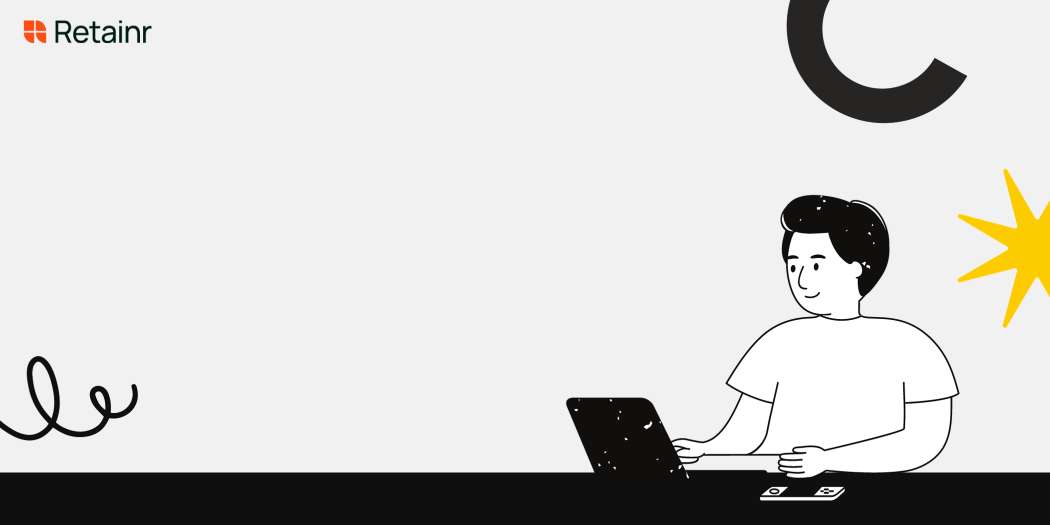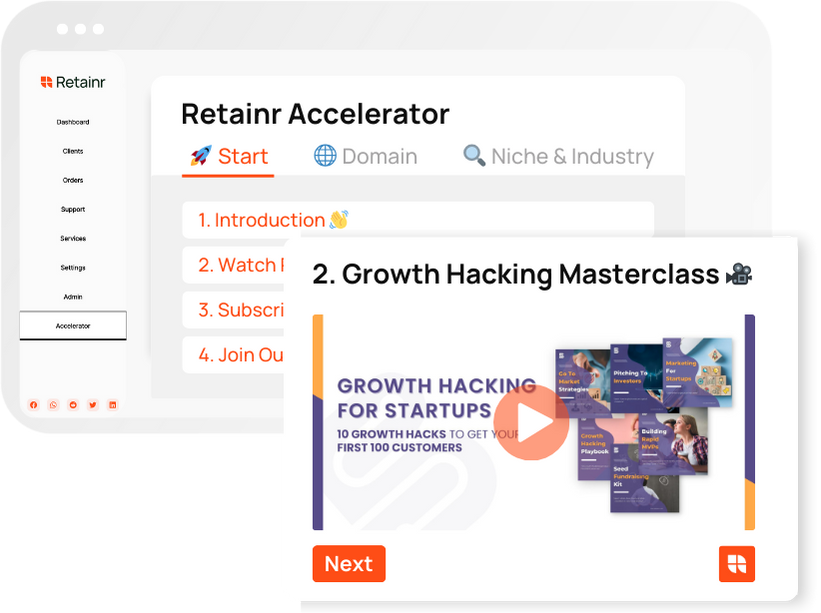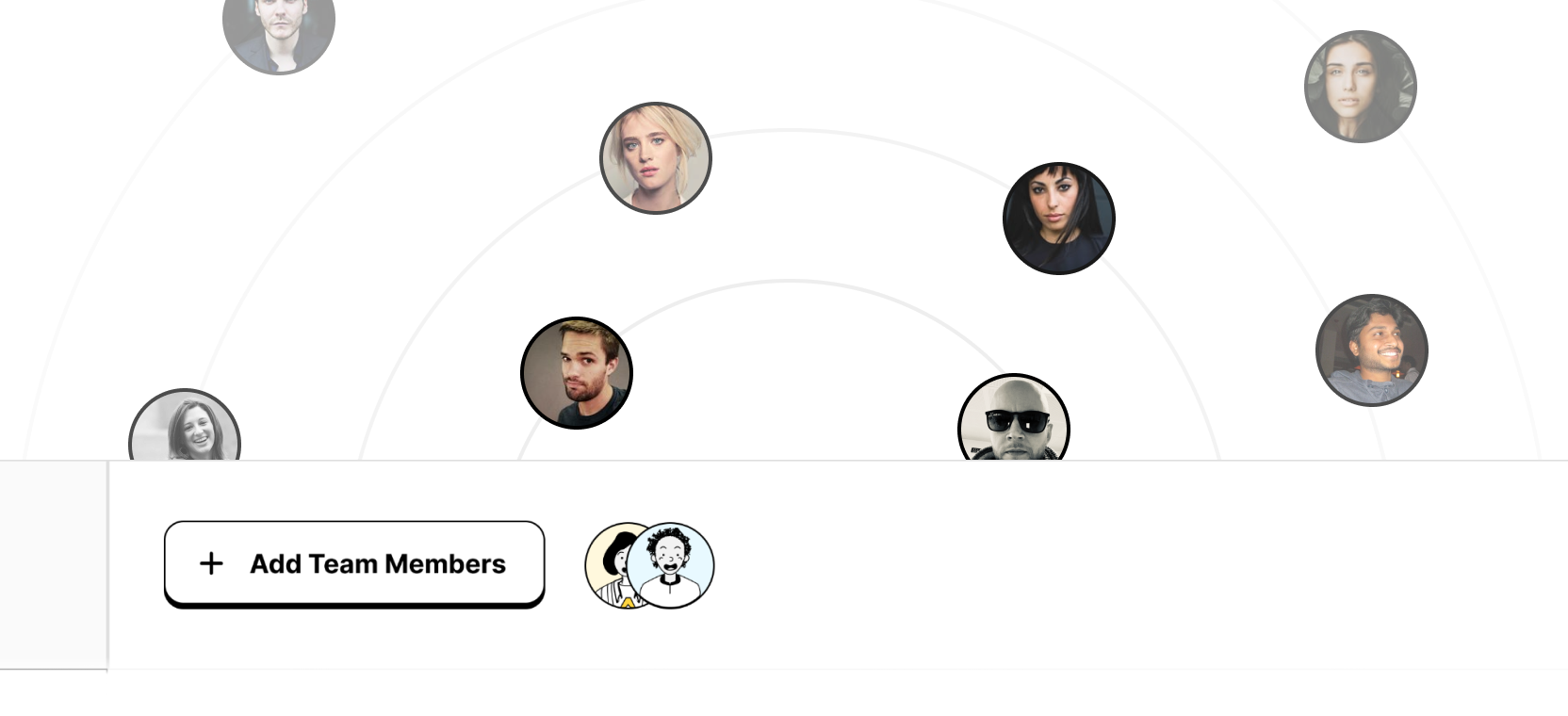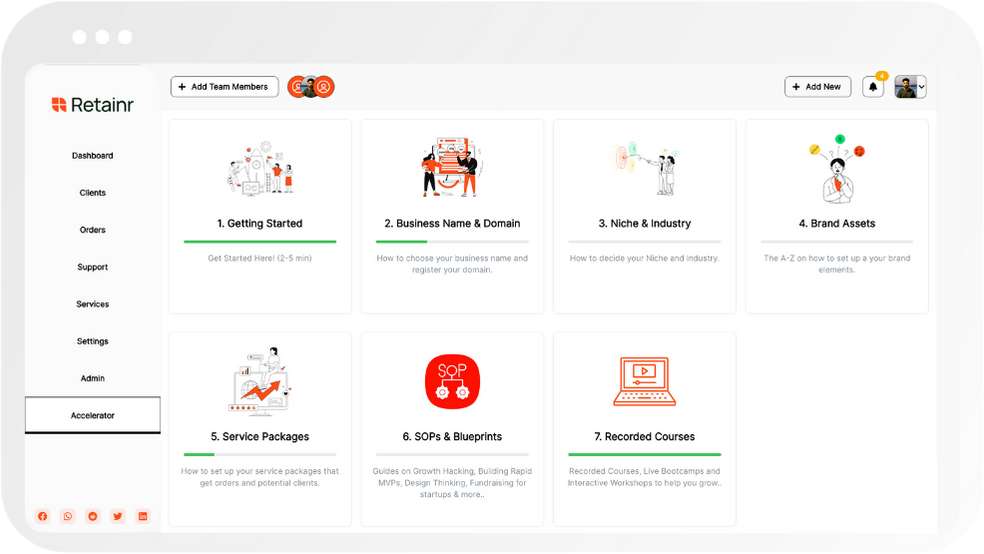
6 Effective Ways for Managing your Work and Responsibilities
Build with Retainr
Sell your products and services, manage clients, orders, payments, automate your client onboarding and management with your own branded web application.
Get Started1. What are the six effective ways for managing my work and responsibilities?
Identify and Prioritize Your Tasks
Knowing what you need to work on and in what order is critical for effective management. Here is an effective way to do so:
- Brainstorm a list of all the tasks that need to get done.
- Identify the tasks that are most urgent or important.
- Break down larger tasks into manageable subtasks.
- Use a tool or method to prioritize these tasks, like the Eisenhowertable.
- Re-evaluate your priorities regularly, as situations can change.
Create a Structure or Schedule
Having a clear structure or schedule to your day can help you stay on track and avoid wasting time. Here are some tips:
- Start each day with a clear plan of what needs to get done.
- Block out specific time slots for different tasks or types of work.
- Try to stick to this schedule as much as possible.
- However, also be flexible and allow for changes or interruptions.
- At the end of the day, review what was achieved and adjust your plan for the next day if needed.
Delegate and Collaborate
If you have the ability to delegate or outsource some of your work, do not hesitate to do so. Working with others can also be very beneficial. Take a look at these guidelines:
| What to Delegate | What to Collaborate On |
|---|---|
| Tasks that others can do more efficiently | Projects requiring diverse skills |
| Routine or repetitive tasks | Tasks where teamwork can improve results |
| Tasks that are not a priority for you | Tasks where shared responsibility can lighten the load |
2. How can I implement these management techniques in my daily work schedule?
Implementation of Management Techniques in Daily Work Schedule
The management techniques can be effortlessly implemented into your daily work schedule by following a number of key steps.
- Task Prioritization: Create a list of tasks, prioritize them based on importance and deal with high priority tasks first. This technique helps in managing tasks effectively and lessens the pressure of last-minute completion.
- Time Blocking: This involves creating blocks of time on your calendar for specific activities. A tool that proves quite valuable for this purpose is Google Calendar.
- Delegating Tasks: Delegation not only lessens your work burden but also gives others a chance to develop their skills. Proper delegation can lead to improved performance and productivity.
- Breaks & Leisure: Taking regular breaks is vital, to maintain the energy levels throughout the day. Spend this time doing things you enjoy or to simply relax and rejuvenate.
Here is an example of how to integrate these techniques in your own schedule:
| 8:00-10:00 AM | Prioritize and start with high priority tasks |
| 10:00-10:15 AM | Short break |
| 10:15-12:00 PM | Continuation of tasks or start with next high priority task |
| 01:00-02:00 PM | Delegation of tasks and follow up on previously assigned tasks |
| 02:00-02:15 PM | Short break |
| 02:15-04:00 PM | Continuation of tasks |
| 04:00-04:15 PM | Short break |
| 04:15-05:00 PM | Wrap up and review of the day's work |
Following the above steps will enable successful time management leading to improved productivity, efficiency and structure within your daily work schedule.
3. Can these management techniques be applied by students or only by professionals?
Applicability of Management Techniques
The six effective ways for managing work and responsibilities can certainly be applied by both students and professionals. In fact, such strategies could be even more beneficial for students as they help to establish productive habits early on, setting the stage for continued success in their professional careers. These techniques not just contribute to a disciplined work regimen, but also boost time management, planning, and organizing skills that are vital in any work environment.
Benefits for Students
- Identification of Priority Tasks: Students often juggle multiple assignments, projects, and responsibilities. The technique of categorizing tasks as per their urgency and importance will help students to focus on high-priority tasks first.
- Time Blocking: Students could utilize this technique to allocate specific time slots for studying, assignments, extracurricular activities, and leisure, ensuring a balanced schedule.
- Delegation: While this may seem applicable only in a team or group project setting, it equips students with the ability to distribute tasks effectively, promoting teamwork and shared responsibility.
Benefits for Professionals
| Technique | Benefit |
|---|---|
| Task Prioritization | Helps in focusing on tasks that are strategic and business-critical, leading to higher efficiency and productivity. |
| Goal-Setting | Establishes a clear direction and provides motivation, leading to increased job satisfaction and personal growth. |
| Time Blocking | Allows for better work-life balance by ensuring specific time for tasks, meetings and personal activities. |
4. What are the benefits of effectively managing your work and responsibilities?
Enhanced Productivity
The most immediate benefit of effectively managing your work and responsibilities is the significant boost in productivity. Efficient work management allows for:
- Higher concentration and focus on tasks
- Reduction in wasted time
- Effective use of available resources
This accelerates operations, as less time is spent on organizing tasks and more on actually doing them.
Reduced Stress
Managing your work and responsibilities effectively drastically reduces stress. This is achieved through:
- Clear goal setting and achieving
- Prevention of work overload
- Avoidance of last-minute rushes and burning out
In the long run, this lead to a better work-life balance, improved mental health and improved quality of life.
Improved Career Growth and Organizational Success
Another significant benefit of an effective work management is the positive impact it has on your professional growth and the success of your organization. By maintaining an organized work structure:
| Impact on Individual | Impact on Organization |
|---|---|
| Enhancement of professional reputation | Increase in overall productivity |
| Increased chances of promotions | Better management of resources |
| Identification and elimination of inefficiencies | Delivery of quality products/ services within stipulated time |
These factors not only guarantee personal job satisfaction but also contribute to the overall success of your organization.
5. How do these techniques help in maintaining a work-life balance?
Techniques to Maintain Work-Life Balance
These techniques can have a substantial impact on maintaining a high-quality work-life balance. It remains essential to manage work and duties judiciously to enhance personal life as well as professional success. Here are some ways these techniques can facilitate improved work-life balance:
- Prevents Overload: Good management of tasks helps to avert work overload, thus reducing stress and unnecessary pressure. This results in healthier mental, emotional, and physical well-being.
- Promotes Productivity: These methods enhance productivity & efficiency and encourage a smoother workflow, allowing better achievement of job outcomes.
- Compartmentalization of Responsibilities: These techniques help segment work and personal routines successfully, warranting that one doesn’t overpower the other.
Quantitative Benefits of Work-Life Balance Techniques
For a clearer picture, let's go beyond qualitative benefits and look at the tangible payoffs of implementing these techniques. By using an illustrative representation in a table format, one can draw an association between effective work-life balance techniques and their corresponding efficiency contribution.
| Techniques | Increase in Efficiency (%) |
|---|---|
| Task management | 30 |
| Time allocation | 40 |
| Delegation of tasks | 35 |
| Use of technology tools | 50 |
Work-Life Balance Adoption Success
Consequently, effective harnessing of the mentioned techniques directly relates to work-life balance success. However, any approach's triumph greatly depends on individual implementation and application. Ingredients for a successful work-life balance may include:
- Understanding and accepting one's limitations.
- Proactively implementing strategies to manage duties.
- Consistent self-monitoring to manage stress and prevent burnout.
- Emphasizing self-care and setting personal boundaries.
6. Does using these techniques help in enhancing work productivity?
Efficiency in Managing Work and Responsibilities
Adopting suitable techniques for managing your work and responsibilities has tangible benefits for work productivity. It’s important to understand that enhancing productivity is not merely about doing more work in less time. Rather, it's about making optimal use of your time and resources to ensure the tasks you're carrying out are adding value to your progress and productivity at work.
- Planning your Day: This allows you to organize your tasks and schedule your day effectively. Consequently, having a clear itinerary eases stress, prevents confusion and boosts your productivity.
- Prioritizing Tasks: Not all tasks carry the same weight. Recognizing the ones that require immediate attention and delivering them on time can significantly improve your productivity.
- Delegating Responsibilities: Understand that you don’t have to do everything yourself. Delegating tasks to appropriate individuals can help take some weight off your shoulders, allowing you to focus on other urgent and important matters.
- Setting Realistic Goals: Breake your goals into smaller, manageable tasks. Achieving these smaller tasks can motivate you and maintain your workflow, increasing productivity.
- Limiting Distractions: Work towards creating a conducive environment for work. Eliminating unnecessary distractions can help you to focus better, thus, enhancing your work productivity.
- Regular Breaks: To ensure you're not overworking yourself, taking regular breaks can help maintain a steady level of performance and avoid burnouts.
Effective Productivity Management Techniques
The table provides a summary of the six techniques for enhancing productivity at work and their respective benefits.
| Technique | Benefit |
|---|---|
| Planning Your Day | Organize work schedule; Ease stress and confusion; Boost productivity |
| Prioritizing Tasks | Identify key tasks; Improve time management; Increase efficiency |
| Delegating Responsibilities | Offload tasks; Ensure appropriate task assignment; Improve focus on key tasks |
| Setting Realistic Goals | Break down goals; Maintain workflow; Enhance motivation |
| Limiting Distractions | Create conducive work environment; Improve focus; Enhance productivity |
| Regular Breaks | Prevent overworking; Maintain performance level; Avoid burnouts |
7. Is there any specific order or method to apply these six effective ways for managing work?
Application Order and Methodology
While there is no hard and fast rule, a recommended approach to applying these six effective management methods would be to follow the sequence in which they were presented. Starting with prioritizing tasks, organizing your workspace, then to setting realistic goals is a logical initial step. Following the goal-setting, focus on effective communication and team work. Lastly, make sure to apply the principles of effective delegation.
Order of Application
- Prioritizing Tasks
- Organizing Your Workspace
- Setting Realistic Goals
- Effective Communication
- Working as a Team
- Delegating Responsibilities
Comparison of the Application Method
| Method | Objective | Application Technique |
|---|---|---|
| Prioritizing Tasks | Managing tasks based on their importance | Using apps or tools for creating a to-do list and prioritize them based on their urgencies. |
| Organizing Your Workspace | Maintaining a clutter-free workspace | Regular cleaning and organizing of the workspace using organizer tools or apps. |
| Setting Realistic Goals | Creating achievable targets | Setting SMART (Specific, Measurable, Achievable, Relevant, Time-bound) Goals. |
| Effective Communication | Fostering better understanding | Practicing active listening, non-verbal communication and providing clear instructions. |
| Working as a Team | Enhancing productivity | Implementing a democratic leadership style and encouraging team participation. |
| Delegating Responsibilities | Optimizing resource utilization | Knowing team member’s capabilities and assigning tasks accordingly. |
8. Can these ways of management be successful in all types of jobs or are they field-specific?
Applicability of Management Strategies Across Various Jobs
The six strategies proposed for effectively managing work and responsibilities can generally be applied across various types of jobs. However, the degree and method of application may differ based on the specific field and job requirements. The adaptability of these strategies to diverse work areas stems from their focus on fundamental aspects of managing tasks and responsibilities, such as setting goals, planning and organizing, prioritizing tasks, delegating tasks effectively, maintaining work-life balance, and focusing on continuous learning and development.
- Setting goals: Applicable to all job types as every work has underlying objectives.
- Planning and organizing: Relevant across multiple job sectors because it aids in streamlining tasks and managing time effectively.
- Prioritizing tasks: Useful in every job scenario as it helps in focusing on critical tasks over less important ones.
- Delegating tasks effectively: Necessary in teamwork oriented jobs and management positions.
- Maintaining work-life balance: Vital for all working individuals to prevent burnout and maintain productivity.
- Continuous learning and development: Important for every job type for career growth and keeping up-to-date with advancements in the field.
Varying Application Based on Job Type
| Job type | Most applicable strategies |
|---|---|
| Entry-Level Jobs | Setting goals, Planning and organizing, Learning and development |
| Management Positions | All, with emphasis on Delegating tasks effectively |
| Freelancing / Self-Employment | All, with emphasis on Maintaining work-life balance |
| Technical/Scientific Jobs | All, with emphasis on Continuous learning and development |
In conclusion, these six strategies could prove essential in managing work and responsibilities, irrespective of job type. Nevertheless, their application may vary in the context of the job, allowing some strategies to be more predominant in certain roles than in others.
9. What challenges might one face when trying to manage their work and responsibilities, and how can they overcome them?
Challenges in Managing Work and Responsibilities
Managing work and responsibilities may present numerous challenges that may hinder effective management. One of the main difficulties includes stress and burnout, which results from handling too many tasks and responsibilities simultaneously. Procrastination is another significant challenge that could result from disorganization or perceived overwhelming workload. Lastly, lack of motivation and low productivity levels may make task and responsibility management an uphill task.
- Stress and burnout: Overworking oneself increases the risk of experiencing stress and burnout, which negatively impacts productivity levels.
- Procrastination: Failing to organize tasks and responsibilities may cause one to procrastinate, thus compromising on task completion and quality.
- Lack of motivation and low productivity: One's productivity levels may plummet if they lack motivation to execute their responsibilities effectively.
Overcoming Challenges in Managing Work and Responsibilities
While these challenges may be a daunting reality in managing tasks and responsibilities, they can be surmounted by employing effective management strategies. Such strategies could include better workload management to prevent burnout, structured planning to address procrastination, and motivation strategies to enhance productivity. Appropriate workload management involves prioritizing tasks based on their urgency and importance, and delegating where possible. Moreover, implementing structured planning strategies, such as task planning, could alleviate procrastination. Motivation strategies to boost productivity could include setting achievable goals, rewarding good performance, and maintaining positive work environments.
| Challenges | Overcoming Strategies |
|---|---|
| Stress and burnout | Better workload management through prioritizing and delegating tasks. |
| Procrastination | Structured planning such as using task planning tools. |
| Lack of motivation and low productivity | Setting achievable goals, rewarding good performance, and maintaining a positive work environment. |
10. Are these techniques applicable globally or do they depend on specific work cultures?
Global Applicability of Effective Work and Responsibilities Management Techniques
The techniques for managing work and responsibilities effectively are generally universal. They embody the core principles of productivity and efficiency that can be applied across different geographic locations and cultural contexts. However, the precise application of these techniques may vary depending on the specific work environment and culture.
General Application in Different Work Cultures
- Goal Setting: This helps in focusing resources and efforts across all work cultures. However, in some cultures, it's common to set collective goals, while in others, individual goal setting is more prevalent.
- Time Management: It is universally applicable but may be adapted differently in some cultures. For instance, cultures that value flexibility may have a different approach to scheduling and punctuality than those that adhere to strict scheduling.
- Task Prioritization: Prioritizing tasks can be done in all work cultures, but the criteria for prioritization may vary. Some cultures might prioritize tasks based on their urgency, while others might consider their importance or the order in which they were received.
Adjustments Depending on Work Cultures
| Technique | Work Culture A | Work Culture B |
|---|---|---|
| Effective Communication | More indirect and formal | More direct and informal |
| Teamwork & Collaboration | Independent work is valued more | Group work and collaboration is highly valued |
| Problem-Solving | Prefers detailed analysis and planning | Embraces quick, intuitive decision-making |
These examples illustrate that while the broader principles of work and responsibilities management are widely applicable, the specifics of their implementation can be adjusted to suit differing work cultures and values.
Conclusion
Effective Management of Work and Responsibilities
Managing your work and responsibilities can sometimes be overwhelming. However, with the right strategy, you can efficiently handle your tasks, orders, and payments. Here are six effective ways to do just that:1. Prioritize your Tasks
Determine which tasks are most urgent and important. This will help you focus on what really matters.2. Time Management
Structure your day in a way that enables you to accomplish your most important tasks during your most productive hours.3. Delegation
Don't be afraid to delegate tasks. This frees up your time so you can focus on strategic decisions that only you can make.4. Use Technology to Your Advantage
With the right tools, you can streamline and automate your processes, significantly reducing your workload. One such tool is Retainr.io, a comprehensive business management platform that can help you sell, manage clients, orders, and payments more efficiently.5. Organize Your Tasks
Have a system in place to organize your tasks. This will help you to easily keep track of your workload and progress.6. Avoid Multitasking
Despite common belief, multitasking can actually diminish productivity. Focus on one task at a time for the best results. To sum up, managing work and responsibilities is a matter of planning, prioritizing, and efficiently using your resources. And of course, don't forget to tap into technology with platforms like Retainr.io, the white-label software that lets you manage your business, your way.Boost Your Agency Growth
with Retainr Accelerator
Uncover secrets, strategies, and exclusive blueprints to take your agency's growth to the next level — from marketing insights to effective presentations and leveraging technology.

SOPs, Cheatsheets & Blueprints
Leverage 50+ SOPs (valued over $10K) offering practical guides, scripts, tools, hacks, templates, and cheat sheets to fast-track your startup's growth.
Connect with fellow entrepreneurs, share experiences, and get expert insights within our exclusive Facebook community.
.jpg)

Join a thriving community of growth hackers. Network, collaborate, and learn from like-minded entrepreneurs on a lifelong journey to success.

Gain expertise with recorded Courses, Live Bootcamps and interactive Workshops on topics like growth hacking, copywriting, no-code funnel building, performance marketing and more, taught by seasoned coaches & industry experts.

.jpg)

.jpeg)


